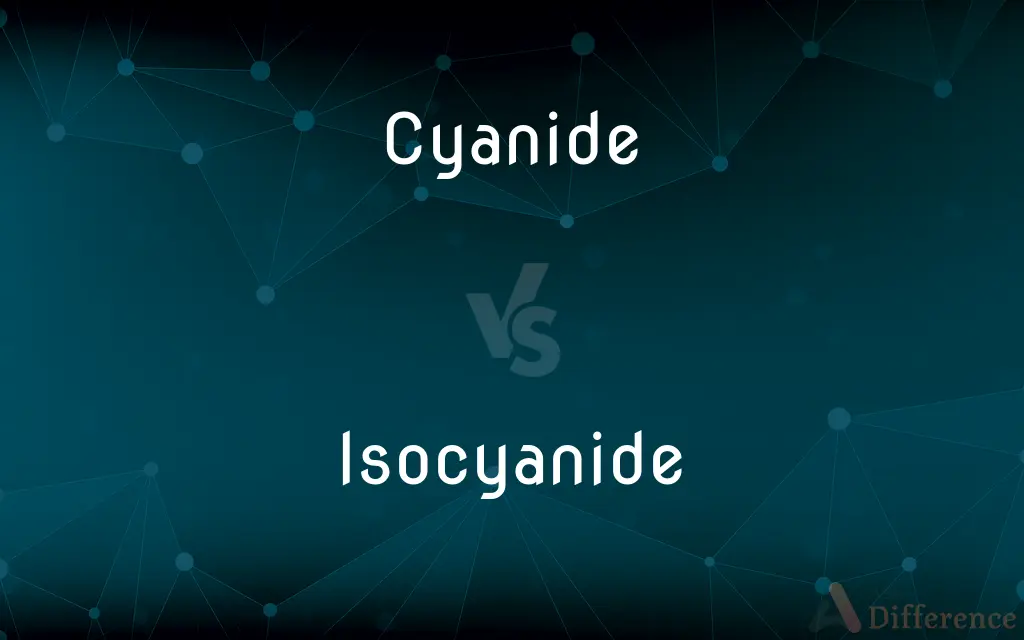Cyanide vs. Isocyanide — What's the Difference?
By Tayyaba Rehman — Published on November 7, 2023
Cyanide, containing a C≡N- group, is a lethal ion/substance. Isocyanide, with a N≡C group, is used in organic syntheses.

Difference Between Cyanide and Isocyanide
Table of Contents
ADVERTISEMENT
Key Differences
Cyanide is commonly recognized in the realm of chemical compounds due to its notorious toxic properties. Its functional group, which is composed of a carbon triple-bonded to a nitrogen (C≡N-), plays a critical role in its characteristics. On the other hand, Isocyanide, not as commonly encountered outside of organic chemistry contexts, features a structure in which the nitrogen is triple-bonded to the carbon (N≡C).
Cyanide is a compound that has been widely recognized for its historical usage in mining to extract gold and other precious metals from ore. Simultaneously, Isocyanides are more niche and are mostly utilized in specialized organic synthesis due to their unique reactivity, making them beneficial for constructing complex organic molecules.
Notably, Cyanides are potent inhibitors of cellular respiration, binding to a critical enzyme and thereby preventing the utilization of oxygen by cells. Conversely, Isocyanides, while having a certain degree of toxicity, are not renowned for this characteristic and play a more significant role in synthetic chemistry.
In various industries, Cyanide compounds find usage due to their ability to react with and bind metals, a property that has also led to their application in electroplating. Isocyanides, given their particular reactivity in organic synthesis, find usage in the creation of various organic compounds, including some pharmaceuticals.
In terms of regulatory attention, Cyanides, due to their toxicity, are subject to numerous regulations globally, ensuring they are handled with utmost care to prevent accidental exposure. Isocyanides, while regulated, are not under the same stringent control due to their lower toxicity and specific usage in chemical syntheses.
ADVERTISEMENT
Comparison Chart
Chemical Structure
Contains a C≡N- group
Contains a N≡C group
Common Usage
Mining, electroplating
Organic syntheses
Toxicity
Highly toxic
Generally less toxic
Regulations
Strictly regulated
Moderately regulated
Industrial Relevance
Widely used in industries
Used in specific contexts
Compare with Definitions
Cyanide
Utilized in the mining industry to extract precious metals.
Cyanide leaching is a common process in gold mining.
Isocyanide
A compound used in organic synthesis.
Methyl isocyanide is used in certain synthetic reactions.
Cyanide
Employed in some manufacturing processes like electroplating.
The cyanide bath is used for electroplating the metal.
Isocyanide
Can be utilized in isocyanide chemistry to create organic molecules.
The isocyanide was employed in a multicomponent reaction.
Cyanide
A lethal chemical compound often recognized for its toxicity.
The presence of cyanide in the solution was confirmed through testing.
Isocyanide
Possesses a distinctive, often unpleasant odor.
The laboratory was evacuated due to the odor of an isocyanide.
Cyanide
Known for inhibiting cellular respiration in organisms.
Cyanide disrupts the electron transport chain within mitochondria.
Isocyanide
Employed in the production of certain pharmaceutical compounds.
Isocyanides are used to construct specific molecules in drug synthesis.
Cyanide
The anionic univalent CN group, or any of various salts or esters of hydrogen cyanide containing a CN group, especially the extremely poisonous compounds potassium cyanide and sodium cyanide.
Isocyanide
Known for its unconventional bonding.
The bonding in isocyanide is described as a bent bond.
Cyanide
To treat (a metal surface) with cyanide to produce a hard surface.
Isocyanide
(chemistry) The isomer HN+C- of hydrocyanic acid HCN.
Cyanide
To treat (an ore) with cyanide to extract gold or silver.
Isocyanide
(chemistry) Any of its hydrocarbyl derivatives RNC.
Cyanide
Any compound containing the -C≡N group or the CN− anion.
Cyanide
(uncountable) Sodium or potassium cyanide, used in the extraction of gold and silver or as a poison.
Cyanide
(uncountable) Hydrogen cyanide, or cyanide gas, a poisonous gas.
Cyanide
(transitive) To treat or poison with cyanide.
Cyanide
A compound formed by the union of cyanogen with an element or radical.
Cyanide
Any of a class of organic compounds containing the cyano radical -CN
Cyanide
An extremely poisonous salt of hydrocyanic acid
Cyanide
Present in certain seeds and fruits in nature.
Bitter almonds contain a small amount of cyanide.
Common Curiosities
Is isocyanide also toxic?
Yes, but typically less toxic than cyanide.
What is cyanide commonly known for?
Cyanide is widely known for its high toxicity.
In which industry is cyanide most frequently used?
It's widely used in mining and electroplating.
Can cyanide be found in nature?
Yes, in certain seeds and fruits like bitter almonds.
Why are isocyanides important in chemistry?
They are valued for their unique reactivity in organic syntheses.
Are there regulations for cyanide usage?
Yes, cyanide use is strictly regulated due to its toxicity.
Is there an antidote for cyanide poisoning?
Yes, hydroxocobalamin is one of the antidotes for cyanide poisoning.
How are isocyanides produced?
They can be produced by the dehydration of formamides.
Why is cyanide used in gold mining?
It's used to leach gold from ores because it binds well with metals.
What is the fundamental structural difference between cyanide and isocyanide?
Cyanide has a C≡N- structure, while isocyanide has a N≡C structure.
Are isocyanides used in mining like cyanides?
No, isocyanides are typically not used in mining processes.
What role do isocyanides play in pharmaceutical chemistry?
Isocyanides are utilized to synthesize various organic compounds in pharmaceuticals.
What distinctive feature do isocyanides have?
Isocyanides are known for their distinctive, often unpleasant odor.
How does cyanide affect cellular processes?
Cyanide inhibits cellular respiration by binding to a critical enzyme.
Are there safety concerns with isocyanides in labs?
Yes, due to their odors and potential toxicity, safe handling and proper ventilation are crucial.
Share Your Discovery

Previous Comparison
Aims vs. Objectives
Next Comparison
Nail Polish vs. Nail EnamelAuthor Spotlight
Written by
Tayyaba RehmanTayyaba Rehman is a distinguished writer, currently serving as a primary contributor to askdifference.com. As a researcher in semantics and etymology, Tayyaba's passion for the complexity of languages and their distinctions has found a perfect home on the platform. Tayyaba delves into the intricacies of language, distinguishing between commonly confused words and phrases, thereby providing clarity for readers worldwide.













































